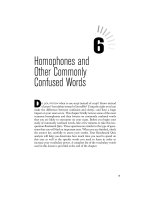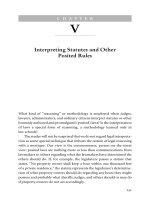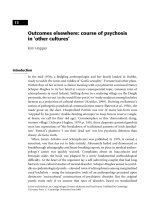Other Probability Distributions
Bạn đang xem bản rút gọn của tài liệu. Xem và tải ngay bản đầy đủ của tài liệu tại đây (2.93 MB, 16 trang )
CHAPTER
8
Other Probability
Distributions
Introduction
The last chapter explained the concepts of the binomial distribution. There
are many other types of commonly used discrete distributions. A few are the
multinomial distribution, the hypergeometric distribution, the Poisson
distribution, and the geometric distribution. This chapter briefly explains
the basic concepts of these distributions.
131
Copyright © 2005 by The McGraw-Hill Companies, Inc. Click here for terms of use.
The Multinomial Distribution
Recall that for a probability experiment to be binomial, two outcomes are
necessary. But if each trial of a probability experiment has more than two
outcomes, a distribution that can be used to describe the experiment is called
a multinomial distribution. In addition, there must be a fixed number of
independent trials, and the probability for each success must remain the same
for each trial.
A short version of the multinomial formula for three outcomes is given
next. If X consists of events E
1
, E
2
, and E
3
, which have corresponding
probabilities of p
1
, p
2
, and p
3
of occurring, where x
1
is the number of times E
1
will occur, x
2
is the number of times E
2
will occur, and x
3
is the number of
times E
3
will occur, then the probability of X is
n!
x
1
!x
2
!x
3
!
Á p
x
1
1
Á p
x
2
2
Á p
x
3
3
where x
1
þ x
2
þ x
3
¼ n and p
1
þ p
2
þ p
3
¼ 1:
EXAMPLE: In a large city, 60% of the workers drive to work, 30% take the
bus, and 10% take the train. If 5 workers are selected at random, find the
probability that 2 will drive, 2 will take the bus, and 1 will take the train.
SOLUTION:
n ¼ 5, x
1
¼ 2, x
2
¼ 2, x
3
¼ 1 and p
1
¼ 0.6, p
2
¼ 0.3, and p
3
¼ 0.1
Hence, the probability that 2 workers will drive, 2 will take the bus, and
one will take the train is
5!
2!2!1!
Áð0:6Þ
2
ð0:3Þ
2
ð0:1Þ
1
¼ 30 Áð0:36Þð0:09Þð0:1Þ¼0:0972
EXAMPLE: A box contains 5 red balls, 3 blue balls, and 2 white balls. If
4 balls are selected with replacement, find the probability of getting 2 red
balls, one blue ball, and one white ball.
SOLUTION:
n ¼ 4, x
1
¼ 2, x
2
¼ 1, x
3
¼ 1, and p
1
¼
5
10
, p
2
¼
3
10
, and p
3
¼
2
10
: Hence, the
probability of getting 2 red balls, one blue ball, and one white ball is
4!
2!1!1!
5
10
2
3
10
1
2
10
1
¼ 12
3
200
¼
9
50
¼ 0:18
CHAPTER 8 Other Probability Distributions
132
PRACTICE
1. At a swimming pool snack bar, the probabilities that a person buys
one item, two items, or three items are 0.3, 0.4, and 0.3. If six people
are selected at random, find the probability that 2 will buy one item,
3 will buy two items, and 1 will buy three items.
2. A survey of adults who go out once a week showed 60% choose a
movie, 30% choose dinner and a play, and 10% go shopping. If 10
people are selected, find the probability that 5 will go to a movie,
4 will go to dinner and a play, and one will go shopping.
3. A box contains 5 white marbles, 3 red marbles, and 2 green marbles.
If 5 marbles are selected with replacement, find the probability that
2 will be white, 2 will be red, and one will be green.
4. Automobiles are randomly inspected in a certain state. The proba-
bilities for having no violations, 1 violation, and 2 or more violations
are 0.50, 0.30, and 0.20 respectively. If 10 automobiles are inspected,
find the probability that 5 will have no violations, 3 will have one
violation, and 2 will have 2 or more violations.
5. According to Mendel’s theory, if tall and colorful plants are crossed
with short and colorless plants, the corresponding probabilities are
9
16
,
3
16
,
3
16
, and
1
16
for tall and colorful, tall and colorless, short and
colorful, and short and colorless. If 8 plants are selected, find the
probability that 3 will be tall and colorful, 2 will be tall and colorless,
2 will be short and colorful and 1 will be short and colorless.
ANSWERS
1. n ¼ 6, x
1
¼ 2, x
2
¼ 3, x
3
¼ 1, and p
1
¼ 0.3, p
2
¼ 0.4, and p
3
¼ 0.3
The probability is
6!
2!3!1!
Áð0:3Þ
2
ð0:4Þ
3
ð0:3Þ
1
¼ 60ð0:001728Þ¼0:10368
2. n ¼ 10, x
1
¼ 5, x
2
¼ 4, x
3
¼ 1, and p
1
¼ 0.6, p
2
¼ 0.3, and p
3
¼ 0.1
The probability is
10!
5!4!1!
ð0:6Þ
5
ð0:3Þ
4
ð0:1Þ
1
¼ 1260ð0:000062986Þ¼
0.07936
CHAPTER 8 Other Probability Distributions
133
3. n ¼ 5, x
1
¼ 2, x
2
¼ 2, x
3
¼ 1, and p
1
¼
5
10
, p
2
¼
3
10
, and p
3
¼
2
10
The probability is
5!
2!2!1!
5
10
2
3
10
2
2
10
1
¼ 30ð0:0045Þ¼0:135
4. n ¼ 10, x
1
¼ 5, x
2
¼ 3, x
3
¼ 2, and p
1
¼ 0.5, p
2
¼ 0.3, and p
3
¼ 0.2
The probability is
10!
5!3!2!
ð0:5Þ
5
ð0:3Þ
3
ð0:2Þ
2
¼ 2520 ð0:00003375Þ¼
0:08505
5. n ¼ 8, x
1
¼ 3, x
2
¼ 2, x
3
¼ 2, x
4
¼ 1, and p
1
¼
9
16
, p
2
¼
3
16
, p
3
¼
3
16
,
and p
4
¼
1
16
The probability is
8!
3!2!2!1!
9
16
3
3
16
2
3
16
2
1
16
1
¼1680ð0:000013748Þ¼
0:0231
The Hypergeometric Distribution
When a probability experiment has two outcomes and the items are selected
without replacement, the hypergeometric distribution can be used to compute
the probabilities. When there are two groups of items such that there are
a items in the first group and b items in the second group, so that the total
number of items is a þ b, the probability of selecting x items from the first
group and n À x items from the second group is
a
C
x
Á
b
C
nÀx
aþb
C
n
where n is the total number of items selected without replacement.
EXAMPLE: A committee of 4 people is selected at random without replace-
ment from a group of 6 men and 4 women. Find the probability that the
committee consists of 2 men and 2 women.
SOLUTION:
Since there are 6 men and 2 women, a ¼ 6, b ¼ 4 and n ¼ 6 þ 4 or 10. Since the
committee consists of 2 men and 2 women, x ¼ 2, and n À x ¼ 4 À 2 ¼ 2.
CHAPTER 8 Other Probability Distributions
134
The probability is
6
C
2
Á
4
C
2
10
C
4
¼
6!
2!4!
Á
4!
2!2!
10!
4!6!
¼
15 Á 6
210
¼
90
210
¼
3
7
% 0:429
EXAMPLE: A lot of 12 oxygen tanks contains 3 defective ones. If 4 tanks
are randomly selected and tested, find the probability that exactly one will
be defective.
SOLUTION:
Since there are 3 defective tanks and 9 good tanks, a ¼ 3 and b ¼ 9. If 4 tanks
are randomly selected and we want to know the probability that exactly one
is defective, n ¼ 4, x ¼ 1, and n À x ¼ 4 À 1 ¼ 3. The probability then is
3
C
1
Á
9
C
3
12
C
4
¼
3!
1!2!
Á
9!
3!6!
12!
4!8!
¼
3 Á 84
495
% 0:509
PRACTICE
1. In a box of 12 shirts there are 5 defective ones. If 5 shirts are sold at
random, find the probability that exactly two are defective.
2. In a fitness club of 18 members, 10 prefer the exercise bicycle and
8 prefer the aerobic stepper. If 6 members are selected at random, find
the probability that exactly 3 use the bicycle.
3. In a shipment of 10 lawn chairs, 6 are brown and 4 are blue. If
3 chairs are sold at random, find the probability that all are brown.
4. A class consists of 5 women and 4 men. If a committee of 3 people is
selected at random, find the probability that all 3 are women.
5. A box contains 3 red balls and 3 white balls. If two balls are selected
at random, find the probability that both are red.
CHAPTER 8 Other Probability Distributions
135
ANSWERS
1. a ¼ 5, b ¼ 7, n ¼ 5, x ¼ 2, n À x ¼ 5 À 2 ¼ 3
The probability is
5
C
2
Á
7
C
3
12
C
5
¼
10 Á 35
792
% 0:442
2. a ¼ 10, b ¼ 8, n ¼ 6, x ¼ 3, n À x ¼ 3
The probability is
10
C
3
Á
8
C
3
18
C
6
¼
120 Á 56
18; 564
% 0:362
3. a ¼ 6, b ¼ 4, n ¼ 3, x ¼ 3, n À x ¼ 3 À 3 ¼ 0
The probability is
6
C
3
Á
4
C
0
10
C
3
¼
20 Á 1
120
¼ 0:167
4. a ¼ 5, b ¼ 4, n ¼ 3, x ¼ 3, n À x ¼ 3 À 3 ¼ 0
The probability is
5
C
3
Á
4
C
0
9
C
3
¼
10 Á 1
84
% 0:119
5. a ¼ 3, b ¼ 3, n ¼ 2, x ¼ 2, n À x ¼ 2 À 2 ¼ 0
The probability is
3
C
2
Á
3
C
0
6
C
2
¼
3 Á 1
15
¼ 0:2
The Geometric Distribution
Suppose you flip a coin several times. What is the probability that the first
head appears on the third toss? In order to answer this question and other
similar probability questions, the geometric distribution can be used. The
formula for the probability that the first success occurs on the nth trial is
ð1 À pÞ
nÀ1
p
where p is the probability of a success and n is the trial number of the first
success.
EXAMPLE: A coin is tossed. Find the probability that the first head occurs
on the third toss.
SOLUTION:
The outcome is TTH; hence, n ¼ 3 and p ¼
1
2
, so the probability of getting two
tails and then a head is
1
2
Á
1
2
Á
1
2
¼
1
8
.
CHAPTER 8 Other Probability Distributions
136









